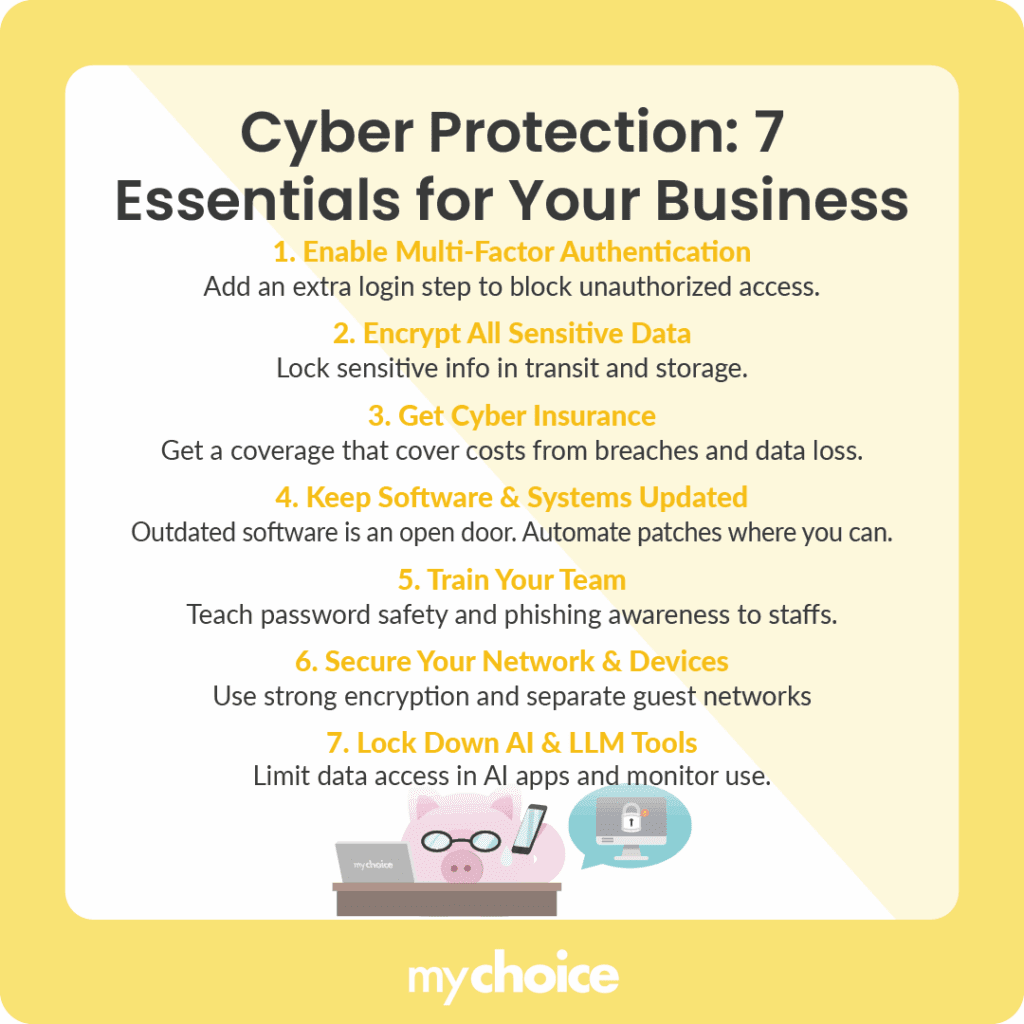Cyber attacks in 2025 are faster, smarter, and harder to detect. Businesses of all sizes are under constant siege from hackers and malicious individuals using AI-enhanced malware, phishing schemes, and data theft strategies. Fortunately, with a proactive mindset and the proper protective measures, your business doesn’t have to be a victim.
What can you do to prevent the likelihood of a data breach? How damaging is a cyber attack? What are the most vulnerable points for a hacker to exploit? Read on to learn why cybersecurity is important, along with seven ways to protect your business from cyber attacks.

1. Use Multi-Factor Authentication
This one might sound simple, but Multi-Factor Authentication (MFA) is one of the most effective tools in your cybersecurity toolkit. MFA requires users to verify their identity through more than one method. This typically involves something they know (like a password) and something they have (like a code from an authenticator app or a fingerprint scan).
These days, passwords alone are no longer sufficient to protect your sensitive data. Adding more layers of protection can nullify most password attack attempts. To keep your business secure, make MFA mandatory across all your systems, from employee logins to customer portals.
2. Encrypt All of Your Sensitive Data
Data encryption is a standard in many industries when it comes to cybersecurity. When you encrypt your data, it’s like you’re locking it in a safe. Even if hackers somehow manage to gain access to your systems and steal your data, they won’t be able to use it without the key. As remote work and cloud storage become more prevalent, data encryption becomes even more critical.
Ensure that all data, from financial information to customer details, is encrypted both in transit and at rest. Cloud services usually offer built-in encryption, as long as you’ve opted to turn it on and properly configure it. For highly sensitive data, consider end-to-end encryption (E2EE) solutions that add an extra layer of control.
3. Get Cyber Insurance
The fight between cybersecurity and hackers is constantly evolving, and sometimes, the hackers get ahead. No matter how secure a system is, there is a chance that a cyber attack will find the holes in your defences. Thankfully, just like a business owner’s policy protects your physical assets, you can insure your digital assets as well.
Some insurance companies offer cyber insurance, which serves as a financial safety net in the event of a breach, covering expenses such as legal fees, data recovery, and even ransomware payments in some instances. Policies can vary greatly, so work with a broker who understands your industry. Look for coverage that includes both first-party (your own losses) and third-party (customer or partner claims) protections. It won’t stop an attack, but it can help you bounce back faster.
4. Make Sure Your Software is Up to Date
Constantly updating software can be annoying and time-consuming, but ignoring a critical security update can cost you big time. Hackers often exploit known software vulnerabilities, and outdated applications are easy targets. Software companies constantly update their products to fix exploits and backdoors that can be used in cyber attacks, so keeping your systems up to date is of utmost importance.
Establish a clear patch management process in your business. That means keeping everything from your operating systems to browser plugins updated regularly. Automate updates where possible, and prioritize critical security patches. Don’t forget about firmware for hardware like routers and printers, as those can be potential vulnerabilities as well.
5. Train Your Staff on Cyber Hygiene
Technology is just half of the cybersecurity equation; your team is the other half. Human error remains one of the biggest causes of data breaches, with 95% of breaches in 2024 involving a human element. Hackers regularly use social engineering and deception to trick your employees into exposing your system to an attack. Regular cybersecurity training is essential if you want your employees to avoid being the doorway for a data breach.
Teach your staff how to spot phishing emails, use strong passwords, and report suspicious activity. Make it part of your onboarding process and run refresher sessions every few months. Simulated phishing attacks are also a great tool; test your team in a safe environment and provide coaching based on results. A well-trained team is your first line of defence.
6. Make Sure Your Wi-Fi Networks Are Secure
An unsecured Wi-Fi network is just a cyber attack waiting to happen. Gaining access to the Wi-Fi network means gaining access to all the devices connected to it and all the data stored on them. Ensure your business network utilizes strong encryption, such as WPA3, and a complex password. If you’re still using default router settings, change them immediately.
Keep your networks segmented. Make sure that your guest Wi-Fi is separate from your internal business network. This limits access points for potential intruders and protects your most critical data. For businesses with remote workers, ensure they use Virtual Private Networks (VPNs) to connect securely from home.
7. Secure Your AI Tools and LLM Integrations
With AI now embedded in everything from customer support to analytics, it’s easy to forget that these tools can introduce new vulnerabilities. If you’re using Large Language Models (LLMs) or AI integrations, be cautious about what data they have access to and how they’re managed. Punching your data into an LLM or AI tool can inadvertently store sensitive information inside its database, allowing ingenious hackers to access that data simply by interacting with the same tool.
Always follow best practices when integrating AI tools: restrict access to sensitive data, audit usage regularly, and avoid feeding proprietary or personal information into third-party tools unless you’re certain it’s protected. Even AI-generated outputs can be manipulated by attackers, so adjust your security protocols to account for both the tools and the data they touch.
Key Advice from MyChoice
- Cybersecurity is a shared responsibility. Every team member, from entry-level to executive, plays a part in keeping your business safe.
- Don’t wait for a cyber attack to happen before you act. Taking proactive steps to prevent attacks and securing business insurance can save you time, money, and your reputation in the long run.
- Get business insurance through MyChoice to make sure that you and your business are protected.








